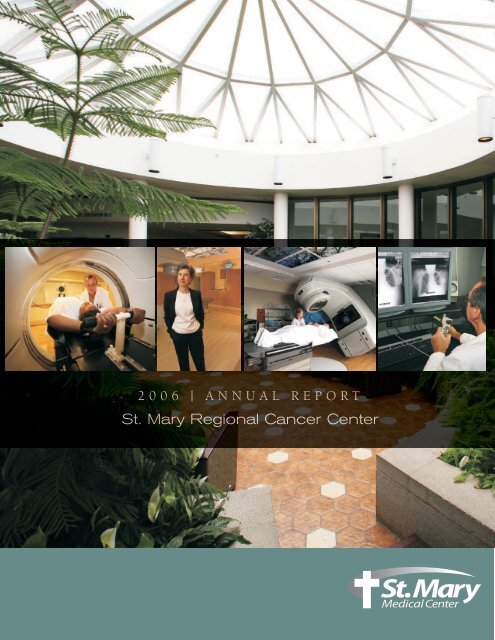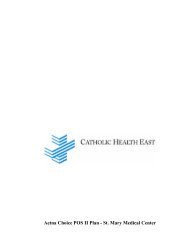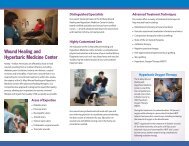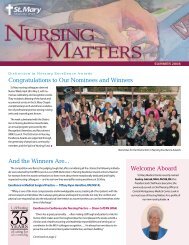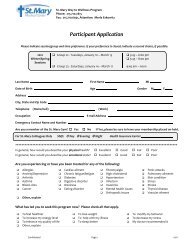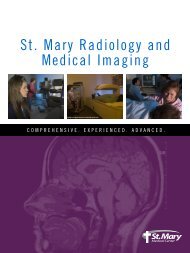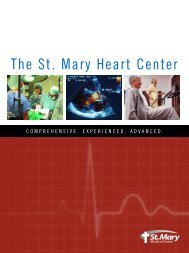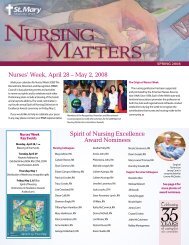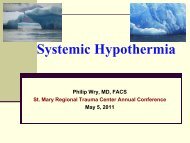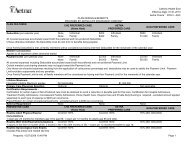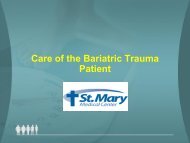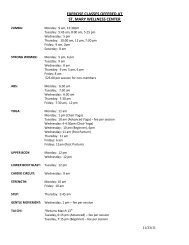Cancer Center Annual Report 2006 - St. Mary Medical Center
Cancer Center Annual Report 2006 - St. Mary Medical Center
Cancer Center Annual Report 2006 - St. Mary Medical Center
You also want an ePaper? Increase the reach of your titles
YUMPU automatically turns print PDFs into web optimized ePapers that Google loves.
2 0 0 6 | A N N U A L R E P O R T<br />
<strong>St</strong>. <strong>Mary</strong> Regional <strong>Cancer</strong> <strong>Center</strong>
CANCER COMMITTEE<br />
Physician Members<br />
Michael P. Mann,<br />
DO, FACOI<br />
Chairman,<br />
<strong>Medical</strong> Oncology<br />
Andrea Barrio, MD<br />
Breast Surgery<br />
Brett L. Moses, MD<br />
Otolaryngology<br />
Robert E. Reilly, DO<br />
Director, <strong>Cancer</strong> Research<br />
<strong>Medical</strong> Oncology<br />
Peter Sinaiko, MD<br />
Urology<br />
Randy Booth<br />
Thoracic Oncology<br />
Coordinator<br />
Joseph Camp, RPh<br />
Pharmacy<br />
Julie Cannan-Siegle<br />
Nutrition<br />
<strong>St</strong>ephanie Loeper<br />
Social Work<br />
Ed Maher<br />
VP/CFO<br />
Theresa McGrath<br />
American <strong>Cancer</strong> Society<br />
Liaison<br />
Richard C. Berg, Jr.<br />
General Surgery<br />
Guillermo J. Bernal, MD<br />
Physical Medicine/Rehab<br />
Robert M. Cardinale, MD<br />
Radiation Oncology<br />
Benjamin S. Chack, DO<br />
<strong>Cancer</strong> Liaison Physician<br />
Otorhinolaryngology–Surgery<br />
Brian Chon, MD<br />
Radiation Oncology<br />
Joseph Conroy, MD<br />
VP, <strong>Medical</strong> Affairs<br />
Zenon Gibas, MD<br />
Pathology<br />
Michael Guttman, MD<br />
<strong>Medical</strong> Oncology<br />
Howard Hammer, DO<br />
Surgery, Otolaryngology<br />
Wayne M. Marley, MD<br />
Dermatology<br />
Diana <strong>St</strong>ripp, MD<br />
Radiation Oncology<br />
Paul Weiser, MD<br />
Radiology<br />
Other Members<br />
Barbara Adons, BSN, RN<br />
Community Health Services<br />
Christine Armetta,<br />
BS, MBA, CCRA<br />
Oncology Research<br />
Coordinator<br />
Margaret Benner<br />
Process Improvement<br />
Coordinator<br />
Robin Bitting<br />
Radiology Services<br />
Jackie Boekel, RT<br />
Radiology & Imaging<br />
Services Director<br />
<strong>Mary</strong> F. Connolly, PA-C<br />
Oncology Research<br />
Coordinator<br />
<strong>St</strong>efanie Crawford, LSW<br />
Supportive/Palliative Care<br />
Patrick Donohue<br />
Marketing &<br />
Communications<br />
<strong>Mary</strong> Doyle, RN<br />
Pain Management Program<br />
Merle Eskowitz<br />
Holistic Health Program<br />
Christine Eustace<br />
Pain Management Program<br />
Vicki Farrell, RN<br />
Radiation Therapy – Nurse<br />
Education<br />
Jane Fridman, RHIT<br />
Tumor Registrar<br />
Sandra Holly, RN, BSN<br />
Nurse Manager Oncology<br />
Sr. Marie Barbara McNamara<br />
Spiritual Care<br />
Suzanne Monte<br />
Administrative Director<br />
Radiology/Oncology<br />
Mital Patel, RHIA, CTR<br />
Lead Tumor Registrar<br />
Charles Quinn, RTT<br />
<strong>Cancer</strong> <strong>Center</strong> Manager<br />
Christina Rybak, MS<br />
Family Risk Evaluation<br />
Program Coordinator<br />
Judy <strong>St</strong>evens, RN, BSN, OCN<br />
Palliative Care/Support<br />
Service<br />
Debbie Thompson-Carry,<br />
RN, BSN, OCN<br />
Oncology Nursing Education<br />
William Trojan, MBA<br />
Oncology Program Director
TABLE OF CONTENTS<br />
I. Chairman’s <strong>Report</strong>.........................................................................................................................................5<br />
II. <strong>Cancer</strong> Support Services...............................................................................................................................8<br />
Clinical Research Program .....................................................................................................................8<br />
Family Risk Evaluation Program ...........................................................................................................8<br />
Diagnostic Radiology .............................................................................................................................9<br />
<strong>St</strong>. <strong>Mary</strong> Breast <strong>Center</strong>..........................................................................................................................10<br />
Radiation Oncology.............................................................................................................................10<br />
Inpatient Oncology Unit......................................................................................................................11<br />
Oncology Nursing Education ..............................................................................................................12<br />
Outpatient Infusion <strong>Center</strong> .................................................................................................................12<br />
Pharmacy.............................................................................................................................................12<br />
Nutritional Counseling ........................................................................................................................13<br />
Pain Management <strong>Center</strong>.....................................................................................................................13<br />
Supportive / Palliative Care..................................................................................................................14<br />
Healing Ministries................................................................................................................................14<br />
Holistic Services...................................................................................................................................15<br />
Social Services .....................................................................................................................................15<br />
Spiritual Care ......................................................................................................................................16<br />
III. <strong>Cancer</strong> Program Activities...........................................................................................................................17<br />
IV. Department of Pathology and Laboratory Medicine.....................................................................................18<br />
V. <strong>Cancer</strong> Registry <strong>Report</strong>................................................................................................................................19<br />
VI. Multidisciplinary <strong>Cancer</strong> Conferences.........................................................................................................21<br />
VII. <strong>St</strong>atistical <strong>Report</strong>s........................................................................................................................................22<br />
A. Risk of Falls for the Aging <strong>Cancer</strong> Population.........................................................................................22<br />
B. Utilizing Partial Breast Irradiation...........................................................................................................24<br />
VIII. Glossary of Terms......................................................................................................................................26<br />
ANNUAL REPORT <strong>2006</strong><br />
<strong>St</strong>. <strong>Mary</strong> <strong>Cancer</strong> <strong>Center</strong><br />
| |
To raise awareness about the importance of routine mammogram screening, the <strong>St</strong>. <strong>Mary</strong> Breast <strong>Center</strong> hosted a town hall meeting<br />
on October 26. CN8’s Lynn Doyle moderated the panel, and the session aired on the Comcast Network. Pictured (from L-R) are:<br />
Dr. William Mechanic, Radiologist; Dr. Robert Reilly, <strong>Medical</strong> Director of <strong>Cancer</strong> Research; Lynn Doyle; Dr. Brian Chon, Radiation<br />
Oncologist; and breast cancer patient Nancy Broadbent.<br />
ANNUAL REPORT <strong>2006</strong><br />
<strong>St</strong>. <strong>Mary</strong> <strong>Cancer</strong> <strong>Center</strong><br />
| |
ON E<br />
CHAIRMAN’S REPORT<br />
This past year has been one of significant progress here at <strong>St</strong>. <strong>Mary</strong>. Since its inception,<br />
<strong>St</strong>. <strong>Mary</strong> has made caring for cancer patients a priority. Now, as a result of the committed efforts<br />
of the Board of Directors and the unfaltering energy of a dedicated staff, we are able to<br />
proudly offer the community the most comprehensive, state-of-the-art cancer management<br />
in a beautiful and convenient setting close to home.<br />
Today’s sophisticated patients are aware of cutting-edge treatments and have a<br />
right to expect no less from their cancer center. That is why <strong>St</strong>. <strong>Mary</strong> has made it<br />
a priority to invest in the most advanced, up-to-date diagnostic and treatment<br />
technologies. By the end of 2007, we will have introduced several outstanding<br />
cancer care services. Because of this commitment, we are recognized as one of<br />
the most progressive cancer care providers in the Southeastern Pennsylvania<br />
region. In this way, at <strong>St</strong>. <strong>Mary</strong> we are able to offer an uncompromised level of<br />
care in a location that is convenient for the families in Bucks County and the<br />
surrounding region.<br />
<strong>St</strong>. <strong>Mary</strong> continues its Community Hospital Comprehensive <strong>Cancer</strong> Program with<br />
Michael P. Mann, DO, FACOI<br />
accreditation from the American College of Surgeons (ACoS) Commission on<br />
<strong>Cancer</strong>. Mindful of ACoS guidelines for quality care, our experts practice every<br />
day with the <strong>St</strong>. <strong>Mary</strong> emphasis on compassion — which is at the core of our values.<br />
ANNUAL REPORT <strong>2006</strong><br />
<strong>St</strong>. <strong>Mary</strong> <strong>Cancer</strong> <strong>Center</strong><br />
| |
PREVENTION<br />
We always have made strong efforts toward cancer prevention,<br />
and as knowledge increases, we continue to adopt measures that<br />
protect our community. Therefore, <strong>St</strong>. <strong>Mary</strong> <strong>Medical</strong> <strong>Center</strong> has a<br />
smoke-free policy throughout its campus. Moving forward, we will<br />
have the breakthrough lung CAD technology that can digitally<br />
spot cancers too small to be seen through conventional x-ray. All<br />
patients ages 30 years or older who need to receive a chest x-ray<br />
for any reason automatically will be screened in this fashion to<br />
detect lung cancer as early as possible. Additionally, <strong>St</strong>. <strong>Mary</strong><br />
continues its practice of offering free cancer-screening days to<br />
the community to educate and to help detect cancers of the<br />
skin, breast, and prostate.<br />
DIAGNOSIS<br />
In addition to our already excellent diagnostic capabilities, the year<br />
has seen the continued utilization and significant success of digital<br />
mammography. <strong>St</strong>. <strong>Mary</strong> anticipates the acquisition of PET/CT<br />
imaging, which will give clinicians more complete insight into the<br />
presence and extent of malignant disease. The accuracy and<br />
precision of this modality are unparalleled, and it will be at <strong>St</strong>. <strong>Mary</strong><br />
in early 2007.<br />
TREATMENT<br />
<strong>St</strong>. <strong>Mary</strong> offers patients true multidisciplinary care. Oncologic<br />
surgeons at <strong>St</strong>. <strong>Mary</strong> are experienced in treating neurologic,<br />
pulmonary, gastrointestinal, genitourinary, gynecologic, orthopedic,<br />
and cutaneous malignancies. Our medical oncologic staff is<br />
expanding and is prepared to intervene in virtually all adult patient<br />
malignancies.<br />
Our Radiation Oncology Department, staffed by experienced<br />
physicians, is now working with the most sophisticated and up-todate<br />
equipment in the region. We offer the patient radiation therapy<br />
(XRT) with conventional external beam therapy through our new<br />
linear accelerator. We have the capability of intensity modulated<br />
radiation therapy (IMRT), as well as conformational XRT that<br />
centers radiation specifically on the tumor, sparing nearby tissues.<br />
In addition to the more conventional radioactive seed form of<br />
brachytherapy, high-dose rate (HDR) brachytherapy will be an<br />
available treatment option. Also in early 2007, <strong>St</strong>. <strong>Mary</strong> will acquire<br />
additional advanced cancer treatment planning and therapeutic<br />
technologies such as Wide Bore CT with respiratory gating and<br />
HI-ART TomoTherapy, which will give us enhanced image-guided<br />
radiation therapy (IGRT) capabilities.<br />
HEALING<br />
At <strong>St</strong>. <strong>Mary</strong>, treatment extends to the whole person — body, mind,<br />
and spirit. Nutritional counseling, meditation, exercise, bodywork<br />
therapies such as massage and Reiki therapy, and spiritual<br />
counseling are important elements of treatment. In continuation<br />
of their invaluable work at <strong>St</strong>. <strong>Mary</strong>, the Social Services and<br />
Spiritual Care Departments provide services such as hospice<br />
intervention, pain management, and spiritual counseling, as well<br />
as bereavement care.<br />
ANNUAL REPORT <strong>2006</strong><br />
<strong>St</strong>. <strong>Mary</strong> <strong>Cancer</strong> <strong>Center</strong><br />
| |
<strong>St</strong>. <strong>Mary</strong> recognizes the need to support not only the cancer patient<br />
but also his or her family in coping with the life changes brought on<br />
by fighting cancer. Therefore, family members are embraced and<br />
incorporated into the healing process.<br />
other primary research hubs, we are expanding opportunities for<br />
research into cancer treatment breakthroughs.<br />
PHYSICAL FACILITIES<br />
EDUCATION<br />
Continuing education opportunities for cancer specialists at <strong>St</strong>.<br />
<strong>Mary</strong> continue to grow. The regularly scheduled tumor conference<br />
has been enhanced by an expanded format. Audiovisual equipment<br />
has been updated, allowing for more active participation by<br />
conference attendees. On a regular basis, experts from many<br />
cancer disciplines present timely topics at these conferences.<br />
A dedicated breast cancer conference meets regularly, as does<br />
our newest thoracic cancer conference.<br />
In June, the <strong>St</strong>. <strong>Mary</strong> Continuing <strong>Medical</strong> Education Committee<br />
hosted its first-ever oncology CME program. During the halfday<br />
event, participants learned about the latest innovations,<br />
discoveries, and changes in the diagnosis, care, and management<br />
of lung, colorectal, prostate, and breast cancers. New trends<br />
in radiation oncology and neuro-oncologic surgery also were<br />
covered. Dr. Michael Mann moderated the program, and session<br />
speakers included Robert Reilly, DO; Robert Cardinale, MD; Carlin<br />
McLaughlin, DO; Evan Alley, MD, PhD; and Nirav Shah, MD.<br />
CLINICAL RESEARCH<br />
<strong>St</strong>. <strong>Mary</strong> also plans to renovate its Inpatient Oncology Unit.<br />
This attractive unit will offer patients private, homelike suites in<br />
the setting of excellent clinical care. The rooms are designed<br />
with comfort and safety, as well as efficiency, in mind. With<br />
computerization, medical records and imaging will be readily<br />
available to the clinician and nursing staff. Private rooms will<br />
minimize disruptions during recovery, while ample common<br />
space, a meeting room, and a tea room will allow for needed<br />
social activity and family interactions. This eagerly awaited new<br />
addition to <strong>St</strong>. <strong>Mary</strong> will serve our community for years to come.<br />
Plans are also in the works to build a Healing Garden specifically<br />
for patients of the <strong>Cancer</strong> <strong>Center</strong>.<br />
The <strong>St</strong>. <strong>Mary</strong> Regional <strong>Cancer</strong> <strong>Center</strong> community can be very proud<br />
of our past year’s accomplishments, but as always, the <strong>St</strong>. <strong>Mary</strong><br />
cancer team will not rest without trying to do even more.<br />
I look to our future with pride and hope.<br />
Michael P. Mann, DO, FACOI<br />
Chairman<br />
Clinical research at <strong>St</strong>. <strong>Mary</strong> continues with renewed vigor. In<br />
partnership with pharmaceutical companies as well as university and<br />
ANNUAL REPORT <strong>2006</strong><br />
<strong>St</strong>. <strong>Mary</strong> <strong>Cancer</strong> <strong>Center</strong><br />
| |
TWO<br />
CANCER SUPPORT SERVICES<br />
<strong>St</strong>. <strong>Mary</strong> <strong>Medical</strong> <strong>Center</strong> takes a team approach to our cancer patients’ diagnosis, treatment,<br />
and holistic healing. Our comprehensive cancer program is recognized not only for its size and<br />
level of sophistication, but also for its commitment to supporting our patients and their families<br />
in every aspect of care—physical, emotional, spiritual, and psychological.<br />
CLINICAL RESEARCH PROGRAM<br />
Residents of Bucks County and surrounding areas stand to benefit from cuttingedge<br />
medical research available at <strong>St</strong>. <strong>Mary</strong> <strong>Medical</strong> <strong>Center</strong>. The <strong>Medical</strong> <strong>Center</strong><br />
works in cooperation with prominent research organizations such as the Eastern<br />
Cooperative Oncology Group (ECOG) and the <strong>Cancer</strong> Trials Support Unit (CTSU),<br />
which are sponsored by the National <strong>Cancer</strong> Institute (NCI). <strong>St</strong>. <strong>Mary</strong> also<br />
participates in clinical trials supported by major pharmaceutical and biomedical<br />
companies. The Research Program operates under the highest standards set<br />
Robert Reilly, DO<br />
by the FDA, NCI, ICH-Good Clinical Practices (GCP), and Office for Human<br />
Research Protections (OHRP). According to the <strong>Medical</strong> Director of Oncology<br />
Research at <strong>St</strong>. <strong>Mary</strong> <strong>Medical</strong> <strong>Center</strong>, Robert Reilly, DO, “<strong>St</strong>. <strong>Mary</strong> <strong>Medical</strong> <strong>Center</strong><br />
has been a significant contributor to medical research for more than 15 years. Our<br />
collaborative efforts with leaders in the field of oncology research allow us to offer<br />
patients clinical trials that previously were available only at large academic centers.”<br />
FAMILY RISK EVALUATION PROGRAM<br />
The Family Risk Evaluation Program was implemented at <strong>St</strong>. <strong>Mary</strong> <strong>Medical</strong><br />
<strong>Center</strong> in 2004. Thanks to the growing interest in this program by physicians and<br />
members of the community, <strong>St</strong>. <strong>Mary</strong> has expanded the program’s options and<br />
clinical services.<br />
The goals of the Family Risk Evaluation Program at <strong>St</strong>. <strong>Mary</strong> <strong>Medical</strong> <strong>Center</strong> are<br />
to educate individuals and families about the role of heredity in cancer risk, to<br />
ANNUAL REPORT <strong>2006</strong><br />
<strong>St</strong>. <strong>Mary</strong> <strong>Cancer</strong> <strong>Center</strong><br />
| |
provide them with up-to-date information regarding<br />
cancer screening and prevention, and to support them<br />
throughout the genetic counseling and testing process.<br />
Initially the program was developed to evaluate the risks<br />
of individuals with a personal or family history of breast<br />
and/or ovarian cancer. In <strong>2006</strong>, services were expanded<br />
to include genetic counseling for colorectal and uterine<br />
cancer risks. Counseling is tailored to the individual risk<br />
profile of each participant based on personal and family<br />
health history. The components of a family risk evaluation<br />
session include the construction of a family tree, an<br />
analysis of the pattern of cancer in the individual’s family,<br />
the use of models to estimate the individual’s risk of<br />
carrying a change in a cancer susceptibility gene, and a<br />
discussion of genetic testing.<br />
Experts affiliated with the Family Risk Evaluation<br />
Program include medical and radiation oncologists,<br />
board-certified breast surgeons, fellowship-trained<br />
general surgeons, gynecologists, social workers,<br />
spiritual care counselors, and genetic counselors.<br />
DIAGNOSTIC RADIOLOGY<br />
<strong>St</strong>. <strong>Mary</strong> <strong>Medical</strong> <strong>Center</strong> is committed to the continuous<br />
investment in diagnostic radiology equipment affording<br />
patients the latest and most accurate technologies available.<br />
In 2007, <strong>St</strong>. <strong>Mary</strong> will implement lung Computer-Aided<br />
Detection (CAD) technology, which will integrate digital<br />
imaging with traditional chest x-ray. The CAD will help<br />
to detect cancerous lesions to the lung in their earliest<br />
stages. It will provide a virtual second opinion from the<br />
collaboration between radiologist and computer. All chest<br />
x-rays conducted for any reason on patients 30 years of<br />
age and older at <strong>St</strong>. <strong>Mary</strong> automatically will be screened<br />
by CAD for lung cancer.<br />
<strong>St</strong>. <strong>Mary</strong> also will add Positron Emission Tomography<br />
(PET)/Computed Tomography (CT) in 2007. PET/CT<br />
integrates two advanced imaging technologies to help<br />
doctors determine the staging of cancer and monitor the<br />
progress of patients’ treatment. This technology will add<br />
a vital dimension to our ability to evaluate patients by<br />
pinpointing malignancies to see where cancer has<br />
spread and how to best treat it.<br />
ANNUAL REPORT <strong>2006</strong><br />
<strong>St</strong>. <strong>Mary</strong> <strong>Cancer</strong> <strong>Center</strong><br />
| |
ST. MARY BREAST CENTER<br />
In September <strong>2006</strong>, <strong>St</strong>. <strong>Mary</strong> <strong>Medical</strong><br />
<strong>Center</strong> opened a Breast <strong>Center</strong> dedicated<br />
to comprehensive breast care, continuing<br />
<strong>St</strong>. <strong>Mary</strong>’s tradition of providing specialized<br />
care for women. At the Breast <strong>Center</strong>, a<br />
team approach offers patients a specialist<br />
for every need. The dedicated staff includes<br />
talented breast surgeons who work closely<br />
with colleagues from Surgery, Pathology,<br />
Radiology, <strong>Medical</strong> Oncology, and Radiation<br />
Oncology. Specialized clinicians work<br />
together to provide coordinated treatment<br />
plans that are appropriate to the individual<br />
needs of women.<br />
A Breast Nurse Specialist coordinates<br />
support resources, accompanying women<br />
through the entire process of diagnostic<br />
testing with advanced digital imaging and —<br />
if faced with an abnormal mammogram<br />
result — follow-up studies such as minimally<br />
invasive breast biopsies. Each patient<br />
receives emotional support as well as expert<br />
care, ranging from chemotherapy and<br />
radiation oncology to surgery and breast<br />
reconstruction.<br />
The Breast <strong>Center</strong>’s full array of the most<br />
advanced women’s health technology<br />
includes:<br />
Digital Mammography<br />
Computer-Aided Detection (CAD)<br />
Breast Ultrasound<br />
Breast MRI<br />
Breast IMRT<br />
Bone Densitometry<br />
Ultrasound-Guided Biopsy<br />
<strong>St</strong>ereotactic Biopsy<br />
Sentinel Node Biopsy<br />
Breast Localization Procedure<br />
Breast Brachytherapy<br />
RADIATION ONCOLOGY<br />
The Radiation Oncology Department here at<br />
<strong>St</strong>. <strong>Mary</strong> Regional <strong>Cancer</strong> <strong>Center</strong> has been<br />
providing outstanding cancer care services<br />
to the community since 1988. <strong>St</strong>. <strong>Mary</strong><br />
<strong>Cancer</strong> <strong>Center</strong> offers a team of prominent<br />
physicians, medical physicists, dosimetrists,<br />
nurses, therapists, and administrative<br />
support staff, who accompany our patients<br />
as they journey through this experience.<br />
The <strong>Cancer</strong> <strong>Center</strong> currently has a stateof-the-art<br />
Linear Accelerator with a 120<br />
dynamic multi-leaf collimator, with IMRT<br />
(Intensity Modulated Radiation Therapy)<br />
capability. IMRT enables the radiation<br />
oncologist to focus the maximum amount<br />
of radiation specifically on cancerous tissue,<br />
while sparing exposure to healthy surrounding<br />
tissue.<br />
Since 1994 the Radiation Oncology<br />
Department also has offered prostate<br />
brachytherapy seed implants, as well as<br />
radionuclide therapy for patients with bone<br />
metastases and blood disorders.<br />
HDR (High Dose Rate) brachytherapy was<br />
implemented in December <strong>2006</strong> for our<br />
ANNUAL REPORT <strong>2006</strong><br />
<strong>St</strong>. <strong>Mary</strong> <strong>Cancer</strong> <strong>Center</strong><br />
| 10 |
<strong>St</strong>. <strong>Mary</strong> Regional <strong>Cancer</strong> <strong>Center</strong> treatment<br />
technology (from left to right): TomoTherapy,<br />
HDR (High Dose Rate) brachytherapy, and IMRT<br />
(Intensity Modulated Radiation Therapy).<br />
patients. HDR involves a protected radiation source placed directly within or near<br />
the tumor site for a short period of time.<br />
Looking ahead to 2007, the Radiation Oncology Department anticipates acquiring<br />
some of the most advanced technologies available to treat cancer. The first<br />
of these will be the installation of a Wide Bore CT Simulator. CT Simulation is<br />
the most comprehensive procedure currently available to reconstruct, localize,<br />
and define a patient’s tumor in three dimensions. This technology will allow the<br />
radiation oncologist to identify the tumor as well as the normal tissue surrounding<br />
it when designing a treatment plan specific to each patient. Also in 2007, the<br />
Radiation Oncology Department plans to offer TomoTherapy, a technology that<br />
represents the future of radiation therapy. TomoTherapy is a form of IMRT that<br />
incorporates a quick CT scan before the commencement of each treatment to<br />
ensure that the tumor is targeted accurately.<br />
Finally, in 2007 the Radiation Oncology Department will be applying for its<br />
ACR (American College of Radiology) radiation oncology accreditation. The<br />
ACR radiation oncology program provides third-party impartial peer review and<br />
evaluation of patient care.<br />
INPATIENT ONCOLOGY UNIT<br />
The Inpatient Oncology Unit of <strong>St</strong>. <strong>Mary</strong> is a 16-bed unit, staffed by registered<br />
nurses, a licensed practical nurse, nursing assistants, and unit secretaries. Our<br />
interdisciplinary approach to care for our patients supports a team effort to<br />
provide quality healthcare and positive patient outcomes. Many of our staff nurses<br />
ANNUAL REPORT <strong>2006</strong><br />
<strong>St</strong>. <strong>Mary</strong> <strong>Cancer</strong> <strong>Center</strong><br />
| 11 |
are active members of the Oncology Nursing Society. We strive to meet all of our<br />
patients’ expectations and to provide the level of care that would inspire them to<br />
recommend <strong>St</strong>. <strong>Mary</strong> <strong>Medical</strong> <strong>Center</strong>.<br />
ONCOLOGY NURSING EDUCATION<br />
<strong>St</strong>. <strong>Mary</strong> <strong>Medical</strong> <strong>Center</strong> offers continued support of the cancer program in its efforts<br />
to meet the educational needs of our patients, their families, our colleagues, and<br />
the community. To achieve this goal, nurses attended inservices that introduced new<br />
chemotherapy medications and regimens. New nurses to the Oncology Department<br />
are provided with a comprehensive orientation program that covers topics such as<br />
types of therapies, nutrition, side effects, solid tumors, and hematologic malignancies. Nurses<br />
with at least two and one-half years of oncology experience are encouraged to achieve and<br />
maintain national certification. Their commitment to oncology nursing is demonstrated by joining<br />
the Oncology Nursing Society, both the national and local chapters.<br />
OUTPATIENT INFUSION CENTER<br />
The Outpatient Infusion <strong>Center</strong> is centrally located within the <strong>St</strong>. <strong>Mary</strong> Regional <strong>Cancer</strong> <strong>Center</strong>.<br />
A team of three nurses provides quality care to a diverse patient population, including patients<br />
with oncologic diagnoses, rheumatoid arthritis, gastrointestinal disorders, and hematological<br />
diseases, as well as other disease processes and disorders. The comprehensive care provided<br />
by the nursing staff incorporates the physical, emotional, and spiritual aspects of patient care,<br />
while professionally and promptly responding to the growing demands for outpatient infusion<br />
therapy of all patient populations. The nursing staff achieves its goal daily of providing quality<br />
healthcare to all patients.<br />
PHARMACY<br />
The pharmacy reviews, prepares, and dispenses chemotherapy medications for inpatients<br />
and outpatients and for research protocols. The pharmacy maintains the inventory and drug<br />
accountability of all research protocols.<br />
In an effort to make chemotherapy preparation and administration as safe as possible, the<br />
pharmacy uses PhaSeal, a closed-system chemo preparation device. The device prohibits the<br />
transfer of environmental contaminants into the system and the escape of hazardous drug<br />
ANNUAL REPORT <strong>2006</strong><br />
<strong>St</strong>. <strong>Mary</strong> <strong>Cancer</strong> <strong>Center</strong><br />
| 12 |
aerosols into the environment, enhancing pharmacy,<br />
nursing, and patient safety.<br />
To ensure that oncology patients have immediate<br />
access to needed medications, especially medications<br />
to control pain and chemo-adverse effects, the<br />
pharmacy maintains a Pyxis (automated dispensing<br />
system) unit on the oncology nursing unit and in the<br />
infusion room.<br />
Pharmacists provide drug information and support to<br />
physicians, nurses, and the research department.<br />
NUTRITIONAL COUNSELING<br />
A registered dietitian provides cancer patients at<br />
<strong>St</strong>. <strong>Mary</strong> <strong>Medical</strong> <strong>Center</strong> with a nutritional plan that<br />
best meets their needs. The oncology dietitian<br />
is involved in the care of outpatients as well as<br />
inpatients. Each patient has the opportunity to request<br />
the services of the dietitian during the course of<br />
chemotherapy and radiation therapy. If a patient is not<br />
going to initiate treatments immediately due to testing<br />
or other factors, the dietitian still will contact the<br />
patient and/or family member by phone to discuss<br />
their nutritional status as requested by the physician<br />
or the patient. The dietitian has the opportunity to<br />
review the nursing assessment form and labs that are<br />
available. All patients who are at nutritional risk are<br />
given the opportunity to see the dietitian and receive<br />
guidance to help them improve their nutritional status.<br />
Other family members are encouraged to be present<br />
for these consultations.<br />
PAIN MANAGEMENT CENTER<br />
The Pain Management <strong>Center</strong> at <strong>St</strong>. <strong>Mary</strong><br />
<strong>Medical</strong> <strong>Center</strong> operates under the leadership of<br />
an outstanding team of physicians, nurses, and<br />
specially trained staff and is located on the ground<br />
floor of the outpatient facility. Our physicians are<br />
anesthesiologists with a sub-specialty in pain<br />
management and have extensive training and<br />
experience to manage oncology pain. In collaboration<br />
with the oncologist, they promote prompt and<br />
effective assessments, diagnosis, and treatment of<br />
pain with oncology patients.<br />
The Pain Management <strong>Center</strong> educates patients and<br />
families regarding options available for pain relief and<br />
ANNUAL REPORT <strong>2006</strong><br />
<strong>St</strong>. <strong>Mary</strong> <strong>Cancer</strong> <strong>Center</strong><br />
| 13 |
encourages active participation in treatment decisions. Oncology<br />
pain and associated symptoms can be aggressively treated with<br />
several methods, including analgesics and ablative procedures, as<br />
well as cognitive strategies. Our physician and nursing staff are<br />
dedicated to excellence in our pursuit of pain control for oncology<br />
patients in our community.<br />
SUPPORTIVE CARE / PALLIATIVE CARE<br />
The supportive care program is a consultant service that addresses<br />
the needs of those with life-limiting illnesses. The supportive care<br />
nurse and supportive care social worker facilitate communication<br />
among the interdisciplinary team, patients, and their families. Supportive<br />
care assists patients and families in identifying preferences<br />
and goals, and provides supportive counseling on decision-making<br />
options. The supportive care team is available to facilitate a plan and<br />
arrange services based on the patient’s and family’s preferences.<br />
Referrals can be initiated from physicians, nurses, social workers,<br />
chaplains, or families and patients. Referrals can be made for both<br />
inpatients and outpatients, patients from the <strong>Cancer</strong> <strong>Center</strong>, or any<br />
physician’s office. The Supportive Care/Palliative Care program was<br />
consulted on behalf of 626 patients in <strong>2006</strong>.<br />
HEALING MINISTRIES<br />
In 2002, the Women’s Guild of <strong>St</strong>. <strong>Mary</strong> established a compassionate<br />
initiative called Healing Ministries. Today, this program offers<br />
customized holistic services, free of charge, to help our cancer<br />
patients cope with the emotional and physical challenges that arise<br />
during diagnosis, treatment, and recovery. As of December <strong>2006</strong>,<br />
564 individuals participated in this program, receiving over 3,200<br />
services and classes.<br />
Healing Ministries ensures a continuum of care. It is the way in<br />
which <strong>St</strong>. <strong>Mary</strong> can extend quality of care beyond leading-edge<br />
treatment to embrace the person who is affected by the disease<br />
physically, emotionally, and spiritually. Healing Ministries also allows<br />
for a multidisciplinary treatment approach by combining the best<br />
medicine has to offer with holistic services such as massage, Reiki,<br />
guided imagery, and more, recognizing that healing is a journey not<br />
only of the body but also of the mind and the heart. The Healing<br />
Ministries program is supported solely through private donations<br />
and fundraising activities such as Circle of Hope Bracelets. It is<br />
<strong>St</strong>. <strong>Mary</strong>’s way of introducing our patients to the concept of true<br />
healing: a caring and compassionate resource that returns quality<br />
of life to a person at a very difficult time.<br />
ANNUAL REPORT <strong>2006</strong><br />
<strong>St</strong>. <strong>Mary</strong> <strong>Cancer</strong> <strong>Center</strong><br />
| 14 |
HOLISTIC SERVICES<br />
Over the past 10 years, the <strong>St</strong>. <strong>Mary</strong> Holistic <strong>Center</strong><br />
has provided healing “companionship” to our patients,<br />
fostering a sense of well-being and helping to reduce<br />
the mental stress and fear that oftentimes accompany<br />
serious diagnoses.<br />
are offered for an outpatient’s convenience in our<br />
Regional <strong>Cancer</strong> <strong>Center</strong> as well as in the privacy of<br />
a patient’s hospital room. Facing a serious diagnosis<br />
such as cancer can create extraordinary stress and<br />
anxiety. Incorporating holistic services into a treatment<br />
plan helps a person feel more in control, more<br />
comfortable, and more a part of their healing journey.<br />
The Holistic <strong>Center</strong> offers a tranquil environment for<br />
patients to unwind, feel nurtured, and experience<br />
deep relaxation through services such as massage<br />
and Reiki. Additionally, mind-body tools such as clinical<br />
hypnosis, guided imagery, or deep breathing techniques<br />
coaching are extremely beneficial in boosting<br />
one’s ability to cope or to prepare for chemotherapy,<br />
radiation, or surgery. Lifestyle enrichment classes<br />
such as yoga, tai chi, or meditation introduce skills for<br />
self-care and self-support. Holistic care at <strong>St</strong>. <strong>Mary</strong><br />
does not mean “alternative” medicine. Rather, it is<br />
our standard of care that addresses the human being<br />
going through the illness and understands that healing<br />
is a journey to be supported mind and body.<br />
In addition to providing therapies within the calm and<br />
serene setting of our Holistic <strong>Center</strong>, services also<br />
SOCIAL SERVICES<br />
The oncology social worker is available to patients<br />
and family members on the oncology inpatient unit.<br />
The social worker also is available to outpatients in<br />
the Regional <strong>Cancer</strong> <strong>Center</strong> and those referred by<br />
the physician. Services provided include psychosocial<br />
assessment, community resource referral, information<br />
on support groups, education, and crisis intervention.<br />
The social worker also can assist patient and family<br />
members in understanding insurance coverage and<br />
benefits associated with discharge planning needs.<br />
The oncology social worker works closely with supportive<br />
care, home care, physicians, nurses, and other<br />
interdisciplinary team members. Supportive services<br />
are available to patients and family members.<br />
ANNUAL REPORT <strong>2006</strong><br />
<strong>St</strong>. <strong>Mary</strong> <strong>Cancer</strong> <strong>Center</strong><br />
| 15 |
SPIRITUAL CARE<br />
Spiritual Care is available to every one of our patients<br />
from the beginning of treatment. <strong>St</strong>. <strong>Mary</strong>’s team of<br />
clerical and lay chaplains supports patients and families<br />
of all faiths as they cope with a cancer diagnosis.<br />
On the inpatient oncology unit this begins at admission,<br />
when a chaplain meets with each patient to assess<br />
spiritual needs. In the <strong>Cancer</strong> <strong>Center</strong>, a chaplain<br />
visits regularly with patients receiving daily treatment,<br />
and is always on call for staff referrals. This continuity<br />
between the <strong>Cancer</strong> <strong>Center</strong> and our inpatient unit<br />
provides a unique opportunity to build a supportive<br />
pastoral relationship at a time when faith and hope<br />
can be most vulnerable.<br />
Spiritual Care works closely with medical staff, social<br />
services, and supportive care, and facilitates bereavement<br />
programs throughout the year with Holistic<br />
Care. In addition, Spiritual Care is in the process of<br />
evaluating and addressing patients’ needs for peer<br />
support, both one-on-one and in a group setting.<br />
ANNUAL REPORT <strong>2006</strong><br />
<strong>St</strong>. <strong>Mary</strong> <strong>Cancer</strong> <strong>Center</strong><br />
| 16 |
TH R E E<br />
<strong>2006</strong> CANCER PROGRAM ACTIVITIES AND AMERICAN<br />
CANCER SOCIETY (ACS) SUPPORT SERVICES<br />
Throughout <strong>2006</strong>, community programs were held in an effort to promote cancer awareness and<br />
educate the general public. The following cancer-related programs were offered by<br />
<strong>St</strong>. <strong>Mary</strong> <strong>Medical</strong> <strong>Center</strong> for their colleagues and the community.<br />
BREAST CANCER SCREENING<br />
AND AWARENESS PROGRAM<br />
October 25, <strong>2006</strong><br />
SCREENINGS<br />
26 screenings were completed; 7 referrals<br />
were made; low cost ($40.00) mammogram<br />
vouchers were offered to all participants.<br />
PROGRAM EXHIBITORS:<br />
<strong>St</strong>. <strong>Mary</strong> Regional <strong>Cancer</strong> <strong>Center</strong><br />
<strong>St</strong>. <strong>Mary</strong> <strong>Medical</strong> <strong>Center</strong> Wellness and Holistic <strong>Center</strong>s<br />
American <strong>Cancer</strong> Society<br />
Healthy Women Program (PA Dept. of Health)<br />
Sale of Circle of Hope Bracelets<br />
SKIN CANCER SCREENING<br />
TOWN HALL MEETING<br />
hosted by CN8’s Lynn Doyle.<br />
Program theme was the importance of the early<br />
detection of breast cancer. Program featured a panel<br />
of <strong>St</strong>. <strong>Mary</strong> physicians: Robert Reilly, DO, <strong>Medical</strong><br />
Oncologist; Brian Chon, MD, Radiation Oncologist;<br />
William Mechanic, MD, Radiologist; and breast<br />
cancer patient Nancy Broadbent. The program was<br />
broadcast and aired several times on CN8.<br />
<strong>St</strong> <strong>Mary</strong> <strong>Medical</strong> <strong>Center</strong> – Regional <strong>Cancer</strong> <strong>Center</strong><br />
May 3, <strong>2006</strong><br />
• 100 individuals were screened, representing more<br />
than a 20 percent increase over the combined total<br />
of the two May 2005 screenings.<br />
RECOMMENDATIONS:<br />
Biopsy – 37<br />
Referrals – 5<br />
PROGRAM ATTENDANCE: 150 participants<br />
ANNUAL REPORT <strong>2006</strong><br />
<strong>St</strong>. <strong>Mary</strong> <strong>Cancer</strong> <strong>Center</strong><br />
| 17 |
FOU R<br />
DEPARTMENT OF PATHOLOGY AND<br />
LABORATORY MEDICINE<br />
The Department of Pathology and Laboratory Medicine provides diagnostic<br />
services to both inpatients and outpatients. <strong>Cancer</strong> diagnosis is a major<br />
focus of the department’s activity.<br />
Surgical pathology cases, which include biopsies and resections, totaled<br />
10,622. The department performed 1,061 non-gynecologic cytology examinations,<br />
which included fine needle aspirations, bronchial brushings, and<br />
body fluids. The Clinical Laboratory performed 1.7 million tests.<br />
Zenon Gibas, MD<br />
The Department offers access to the newest diagnostic modalities, including<br />
molecular pathology, through the use of our own resources and a carefully<br />
selected group of reference laboratories.<br />
The Laboratory continues to be accredited by the College of American<br />
Pathologists, with renewal in December 2008, and is accredited by the<br />
American Association of Blood Banks, the <strong>St</strong>ate of Pennsylvania, and the<br />
Federal Government through the CLIA program. The department is staffed<br />
by three pathologists, all of whom are certified in Anatomic and Clinical<br />
Pathology. Members of the department are involved in medical staff<br />
activities related to oncology programs, such as Tumor Board and the<br />
<strong>Cancer</strong> Committee.<br />
ANNUAL REPORT <strong>2006</strong><br />
<strong>St</strong>. <strong>Mary</strong> <strong>Cancer</strong> <strong>Center</strong><br />
| 18 |
FIVE<br />
CANCER REGISTRY REPORT<br />
The <strong>Cancer</strong> Registry is an integral part of the <strong>St</strong>. <strong>Mary</strong> <strong>Medical</strong><br />
250<strong>Center</strong> <strong>Cancer</strong> Program. The Registry maintains an electronic<br />
database system, which is used for the collection, management, <strong>2006</strong><br />
200and analysis of data on over 14,000 patients diagnosed and/or<br />
2005<br />
treated with reportable cases of cancer at <strong>St</strong>. <strong>Mary</strong> <strong>Medical</strong><br />
150<br />
<strong>Center</strong> since 1987. The database system continues to be upgraded<br />
to ensure that all documentation will comply with Commission<br />
100<br />
on <strong>Cancer</strong> Program <strong>St</strong>andards. In compliance with state and<br />
national mandates, the registry submits data to the Pennsylvania<br />
Department of Health <strong>St</strong>atistics and to the American College of<br />
Surgeons (ACoS) through their Commission on <strong>Cancer</strong>’s National<br />
<strong>Cancer</strong> Data Base (NCDB). The NCDB utilizes this information<br />
to conduct important annual studies to improve the care and<br />
treatment of cancer patients. The data collected in the registry is<br />
routinely reviewed for accuracy and completeness by the <strong>Cancer</strong><br />
Committee physicians and the appointed liaison physician.<br />
50<br />
0<br />
0-29<br />
30-39<br />
40-49<br />
50-59<br />
60-69<br />
70-79<br />
80-89<br />
90+<br />
Graph 1<br />
Frequency of <strong>Cancer</strong><br />
Top 5 Sites <strong>2006</strong><br />
In <strong>2006</strong>, there were 974 new cancer cases accessioned into the<br />
<strong>Cancer</strong> Registry, of which 891 cases were analytic and 83 nonanalytic<br />
cases. The registry has a total number of 14,885 cases<br />
since the reference date of January 1, 1987. A successful<br />
38%<br />
26%<br />
BREAST<br />
LUNG<br />
COLORECTAL<br />
PROSTATE<br />
follow-up rate on more than 5,600 patients is maintained,<br />
and the registry responds to all inquiries from other facilities<br />
for follow-up information in accordance with confidentiality<br />
standards. The cancer registry also maintains a 90% follow-up<br />
rate in compliance with the American College of Surgeons<br />
5%<br />
7%<br />
12%<br />
12%<br />
BLADDER<br />
ALL OTHER<br />
<strong>Cancer</strong> Program <strong>St</strong>andards. Regular follow-up visits for a cancer<br />
patient are important not only for the registry to maintain<br />
accurate follow-up, but also for the patient, since early detection<br />
is the link for long survival when cancer recurs.<br />
Quality improvement projects, with which the registry<br />
participates, reinforce the <strong>Cancer</strong> Program’s commitment to<br />
quality of care and service. The registry actively participated<br />
in 17 case presentation <strong>Cancer</strong> Conferences that provide<br />
consultative information to physicians caring for cancer patients.<br />
90+<br />
ANNUAL REPORT <strong>2006</strong><br />
<strong>St</strong>. <strong>Mary</strong> <strong>Cancer</strong> <strong>Center</strong><br />
| 19 |
Graph 2<br />
Top Sites SMMC vs. <strong>St</strong>ate Projected<br />
70<br />
60<br />
50<br />
40<br />
30<br />
20<br />
10<br />
PERCENTAGE<br />
30<br />
24<br />
18<br />
12<br />
6<br />
0<br />
BREAST<br />
BRONCHUS<br />
+ LUNG<br />
Anus 3<br />
Bladder 45<br />
Blood/Bone Marrow 9<br />
Brain 26<br />
Breast 235<br />
Cervix Uteri 4<br />
ST. MARY<br />
COLORECTAL<br />
SITE<br />
Colorectal 108<br />
(Colon 79, Rectum/<br />
Rectosigmoid 29)<br />
Corpus Uteri 36<br />
Esophagus 14<br />
Eye 1<br />
Fallopian Tube 1<br />
Gallbladder 3<br />
Kidney/Renal 16<br />
Larynx 10<br />
Liver 9<br />
Lung 107<br />
PROSTATE<br />
STATE<br />
BLADDER<br />
Table 1<br />
<strong>2006</strong> Analytic Primary Site Table<br />
250<br />
200<br />
150<br />
100<br />
50<br />
Lymph Nodes/NHL/HL 34<br />
Oral Cavity/Pharynx 22<br />
Other 17<br />
Ovary 11<br />
Pancreas<br />
38%<br />
18<br />
Penis 1<br />
Prostate 64<br />
Retroperitoneum 2<br />
Skin/Melanoma 28<br />
Small Intestine 2<br />
Soft Tissue<br />
5%<br />
7<br />
<strong>St</strong>omach 5<br />
Testis 6<br />
Thyroid/Endocrine 39<br />
Vagina 1<br />
Vulva 7<br />
TOTAL 891<br />
0<br />
0-29<br />
7%<br />
The Primary Site Table in this report (Table 1)<br />
shows a breakdown of the anatomical sites for all<br />
the cancers that were diagnosed and/or treated<br />
here for the year <strong>2006</strong>.<br />
26%<br />
BREAST<br />
The Frequency of <strong>Cancer</strong> graphs (Graph 1 and<br />
LUNG<br />
Graph 2) represent the most common cancers<br />
COLORECTAL<br />
that were diagnosed and treated at <strong>St</strong>. <strong>Mary</strong><br />
<strong>Medical</strong> <strong>Center</strong> in <strong>2006</strong>. Breast PROSTATE cancer is the<br />
most frequently diagnosed cancer BLADDER at <strong>St</strong>. <strong>Mary</strong>,<br />
with 235 new cases accounting ALL for OTHER 26% of our<br />
analytic caseload in <strong>2006</strong>. There were 108 cases<br />
12%<br />
of colorectal cancer, accounting for 12%; 107<br />
new cases of lung cancer, accounting for 12%;<br />
64 cases of prostate cancer, accounting for 7%;<br />
and 45 cases of bladder cancer, accounting<br />
for 5%.<br />
12%<br />
<strong>2006</strong><br />
2005<br />
The registry maintains accurate <strong>Cancer</strong> Conference<br />
compliance information. Through the year, the<br />
registrars attend seminars that enable them to<br />
update and sharpen the mechanisms of data<br />
30-39 40-49 50-59 60-69 70-79 80-89 90+<br />
management in the registry system.<br />
0<br />
0-29 30-39 40-49 50-59 60-69 70-79 80-89 90+<br />
ANNUAL REPORT <strong>2006</strong><br />
<strong>St</strong>. <strong>Mary</strong> <strong>Cancer</strong> <strong>Center</strong><br />
| 20 |
SIX<br />
MULTIDISCIPLINARY CANCER CONFERENCES<br />
<strong>St</strong>. <strong>Mary</strong> Regional <strong>Cancer</strong> <strong>Center</strong><br />
strives to conduct its <strong>Cancer</strong><br />
Conference meetings with a<br />
multidisciplinary approach. The<br />
<strong>Cancer</strong> Conference meets at least<br />
twice per month and discusses<br />
patients who reflect a variety of<br />
cancer types (lung, breast, prostate,<br />
head and neck, gastrointestinal/<br />
colorectal, lymphoma, urologic, and<br />
blood) treated at <strong>St</strong>. <strong>Mary</strong> <strong>Medical</strong><br />
<strong>Center</strong>. Each month, one conference<br />
addresses a general cancer concern,<br />
and sometimes includes an outside<br />
speaker. In addition, specific<br />
conferences relating to breast<br />
cancer and thoracic oncology<br />
have been carved out to meet<br />
more regularly in response to the<br />
physician community. All of these<br />
conferences are multidisciplinary<br />
and involve active participation<br />
by members of the <strong>Medical</strong><br />
Oncology Department, Radiation<br />
Oncology Division, Pathology,<br />
Radiology, General Surgery, the<br />
surgical subdivision, and general<br />
medicine. The conferences are well<br />
attended and provide not only a<br />
forum for discussion of individual<br />
patient treatment plans, but also an<br />
informative educational conference<br />
for members of the hospital<br />
community.<br />
The majority of the cancer<br />
conferences are discussions of<br />
current patients, with the cases of as<br />
many patients as possible reviewed<br />
prior to institution of treatment plan<br />
to allow for input from a variety<br />
of specialists. In <strong>2006</strong>, physicians<br />
discussed a total of 91 cases at 17<br />
case presentation conferences and<br />
4 didactic lectures. The <strong>Cancer</strong><br />
Conferences are committed to<br />
furthering their educational role<br />
in providing information to the<br />
hospital community about cancer<br />
diagnosis and treatment, both in<br />
the discussion of individual patients<br />
and in the general discussions held<br />
during these conferences.<br />
The following is a list of lectures from outside<br />
speakers that were offered at the <strong>Cancer</strong><br />
Conferences in <strong>2006</strong>:<br />
FEBRUARY 2<br />
Patricia Robinson, MD<br />
“Evaluating Aromatase Inhibitors (AIs)<br />
in Adjuvant Setting”<br />
JUNE 15<br />
Bruce Minsky, MD<br />
“Adjuvant Therapy for Rectal <strong>Cancer</strong>”<br />
AUGUST 17<br />
Vatsala Bhardwaj, MD<br />
“Diffuse Large B-cell Lymphoma”<br />
DECEMBER 7<br />
Tiffany Traina, MD<br />
“Maximizing Metastatic Breast <strong>Cancer</strong> Treatment”<br />
ANNUAL REPORT <strong>2006</strong><br />
<strong>St</strong>. <strong>Mary</strong> <strong>Cancer</strong> <strong>Center</strong><br />
| 21 |
SEVE N<br />
STATISTICAL REPORTS<br />
STU DY 1:<br />
The increased risk of falls for the aging cancer population<br />
BACKGROUND<br />
<strong>Cancer</strong> is primarily a disease of older adults. Approximately<br />
60% of all cancers occur in those older than age 65. Therefore,<br />
as the population of the United <strong>St</strong>ates continues to see rapid<br />
demographic shifts in the old (i.e., those older than age 65)<br />
and the old-old (i.e., those older than age 85), the number of<br />
older adults receiving cancer care will be unprecedented.<br />
Falls are one of most common geriatric syndromes. In the<br />
United <strong>St</strong>ates, 30 to 40 percent of adults older than 65 fall<br />
each year. Risk factors include age, muscle weakness,<br />
activities of daily living, and impairments in gait, balance,<br />
vision, and cognition.<br />
RISK FACTORS<br />
People with cancer often have multiple risk factors for falls. A<br />
major risk factor is aging; because people often are diagnosed<br />
with cancer at an older age or are living longer with cancer,<br />
many are at risk for falls. Additional risk factors include<br />
impaired physical function, sensory neurological deficits, use<br />
of multiple medications, and deconditioning, often caused by<br />
treatment-induced fatigue. Of all types of accidents, falls pose<br />
the most serious threat to the elderly. A detailed understanding<br />
and awareness of the risk factors (both intrinsic and extrinsic)<br />
and problems associated with falls can assist oncology nurses<br />
to be vigilant in the identification of patients at high risk<br />
for falls.<br />
DEMOGRAPHIC SHIFT<br />
About 4 million people in the U.S. today are 85 or older; by<br />
the year 2030, this age group will grow to 9 million people.<br />
The number of Americans over 65 is expected to double by<br />
2030 to 65 million; 9 million will be over 85, compared with<br />
4 million today. The U.S. Census Bureau projects a 75 percent<br />
increase in the population ages 65 and older by 2030, bringing<br />
the number of Americans in this age group to 69 million,<br />
accounting for more than 20 percent of the population.<br />
Nutrition is a challenge for clinicians when treating elderly<br />
cancer patients because weight loss is the common presenting<br />
symptom. Body mass index or biochemical parameters<br />
(albumin or total protein) can be used in the assessment<br />
process.<br />
Pain is another domain that should be assessed both before<br />
and during treatment. Whether tumor-related (pressure<br />
caused by tumors) or potential acute reactions (skin reactions),<br />
clinicians should assess pain at each visit.<br />
Graph 3 shows the average age for cancer patients slightly<br />
increased at <strong>St</strong>. <strong>Mary</strong> <strong>Medical</strong> <strong>Center</strong> from 2005 to <strong>2006</strong>.<br />
Cognitive functioning plays a major role in the management<br />
of the elderly cancer patient. Baseline assessment of mental<br />
ANNUAL REPORT <strong>2006</strong><br />
<strong>St</strong>. <strong>Mary</strong> <strong>Cancer</strong> <strong>Center</strong><br />
| 22 |
Graph 3<br />
Number of cancer patients at <strong>St</strong>. <strong>Mary</strong> in each age group<br />
Table 2<br />
Number of falls in the Oncology Unit per month<br />
STATE<br />
250<br />
200<br />
150<br />
<strong>2006</strong><br />
2005<br />
<strong>2006</strong> 2007<br />
January 4 0<br />
February 2 2<br />
March 3 3<br />
April 1 2<br />
May 1 3<br />
100<br />
June 2 0<br />
July 3 0<br />
E<br />
BLADDER<br />
50<br />
0<br />
0-29<br />
30-39<br />
40-49<br />
50-59<br />
60-69<br />
70-79<br />
80-89<br />
90+<br />
* data not yet<br />
available<br />
August 4 *<br />
September 2 *<br />
October 3 *<br />
November 1 *<br />
December 1 *<br />
Totals 27 10<br />
9 80-89 90+<br />
deterioration (failing memory, emotional<br />
irritability, confusion, anxiety, depression,<br />
delusions, hallucinations, and even<br />
dementia) is gathered at consultation<br />
38%<br />
and should be obtained at the onset of<br />
radiation therapy. When treating the brain<br />
with radiation, cerebral edema can quickly<br />
change the mental and physical status of<br />
the older adult, and distinctions need to<br />
be made rapidly.<br />
5%<br />
12%<br />
7%<br />
Findings/Recommendations<br />
Monitoring and tracking falls in the aging<br />
cancer population will be essential to see if<br />
improvement methods are effective or need<br />
to be changed and modified.<br />
Healthcare institutions need to reshape the<br />
way they think about falls by changing the<br />
26%<br />
focus from being reactive to proactive. This<br />
will continue to be a bigger problem as the<br />
aging population grows.<br />
Institutions need to develop risk assessment<br />
tools for identifying at-risk cancer patients<br />
12%<br />
who may benefit from interventions to<br />
reduce the incidence and severity of falls,<br />
and to reduce BREAST the costs of falls.<br />
LUNG<br />
Risk of falls should be evaluated at any<br />
COLORECTAL<br />
clinician’s visit with elderly patients.<br />
PROSTATE<br />
Comprehensive geriatric assessment (CGA)<br />
BLADDER<br />
should be performed before radiotherapy to<br />
establish baseline ALL OTHER functioning.<br />
Exercise also has been shown to be beneficial<br />
to people of all ages, as it helps to lower<br />
blood pressure, lower the risks of falls and<br />
serious injuries (such as hip or wrist fractures),<br />
and slow the body’s loss of muscle<br />
and bone mass.<br />
<strong>St</strong>. <strong>Mary</strong> <strong>Medical</strong> <strong>Center</strong> has implemented<br />
the following process improvement initiatives<br />
in response to this issue:<br />
• Increase rounding on all patients to<br />
identify at-risk patients<br />
• Use of bed alarms for all questionable<br />
patients, even if there is no history<br />
of falls<br />
• Use Posey alarms for all patients who<br />
are identified with cognitive impairment<br />
(confusion, etc.) until their<br />
status changes<br />
Table 2 shows that the initiatives taken to<br />
reduce falls have made a positive impact<br />
but need to be monitored continually for<br />
long-term effectiveness. Of note, falls decreased<br />
by 1 fall per month when comparing<br />
the first seven months of <strong>2006</strong> (2.3) vs.<br />
2007 (1.4).<br />
References<br />
Aging Profile. U.S. Census Bureau. (2000).<br />
Holley, Sandra (2002). “A Look at the Problem of<br />
Falls Among People with <strong>Cancer</strong>.” Clinical Journal of<br />
Oncology Nursing. 6(4): 193-197.<br />
“Importance of Geriatric Assessments While Undergoing<br />
Radiotherapy.” (2004). Geriatric Nursing.<br />
25(6): 355-360.<br />
Kagan, S.H. (2004). “Gero-oncology nursing research.”<br />
Oncology Nursing Forum. 31:296-299.<br />
Yancik, R., & Ries, L.A. (2000). “Aging and cancer in<br />
America: Demographic and epidemiologic perspectives.”<br />
Hematology and Oncology Clinics of North<br />
America. 14:17-23.<br />
ANNUAL REPORT <strong>2006</strong><br />
<strong>St</strong>. <strong>Mary</strong> <strong>Cancer</strong> <strong>Center</strong><br />
| 23 |
STU DY 2:<br />
Breast <strong>Cancer</strong> – “Utilizing Partial Breast Irradiation”<br />
Background<br />
Breast cancer is the most common cause<br />
of cancer in women and the second<br />
most common cause of cancer death in<br />
women in the United <strong>St</strong>ates. While the<br />
majority of new breast cancers are diagnosed<br />
as a result of an abnormality seen<br />
on a mammogram, a lump or change in<br />
consistency of the breast tissue also can<br />
be a warning sign of the disease.<br />
Heightened awareness of breast cancer<br />
risk in the past decades has led to an<br />
increase in the number of women undergoing<br />
mammography for screening,<br />
leading to detection of cancers in earlier<br />
stages and a resulting improvement in<br />
survival rates. Even so, breast cancer<br />
is the most common cause of death in<br />
women between the ages of 45 and 55.<br />
One out of every eight women in the<br />
United <strong>St</strong>ates develops breast cancer.<br />
The causes of breast cancer are not yet<br />
fully known although a number of risk<br />
factors have been identified.<br />
Treatment<br />
Women with breast cancer have many<br />
treatment options, including surgery,<br />
radiation therapy, chemotherapy, and<br />
hormone therapy. The choice of treatment<br />
depends mainly on the stage of the<br />
disease, and many women receive more<br />
than one type of treatment.<br />
New advances in the treatment of breast<br />
cancer have led clinicians to new techniques<br />
in the radiation oncology field.<br />
One of these promising new radiation<br />
techniques is partial breast irradiation.<br />
Partial breast irradiation (PBI) attempts<br />
to focus the powerful treatment on just<br />
the areas most likely to harbor stray cancer<br />
cells, namely those near the original<br />
tumor. PBI was developed to minimize<br />
radiation treatment length while circumventing<br />
recurrence and to ensure the<br />
best cosmetic outcomes.<br />
Another advantage of PBI is compression<br />
of treatment time down to less than<br />
one week, compared with six weeks for<br />
standard whole breast external beam<br />
treatments. Four techniques are available<br />
to deliver PBI. These are interstitial<br />
brachytherapy multicatheter systems, the<br />
Mammosite Radiation Therapy System<br />
applicator, external beam three-dimensional<br />
conformal radiation therapy, and<br />
intraoperative radiation therapy.<br />
Treatment Outcomes<br />
While more clinical studies need to be<br />
conducted to support the data currently<br />
available regarding PBI treatment<br />
outcomes, preliminary Phase I & II trials<br />
show that partial breast irradiation may<br />
work as well as whole breast radiation.<br />
Phase III trial data is still pending.<br />
There are side effects associated with<br />
each treatment, including possible<br />
increased skin erythema, infections, and<br />
persistent seroma formations. However,<br />
if PBI treatments are proven safe and<br />
effective, quality of life will be improved<br />
for many women with breast cancer. PBI<br />
also would provide a more convenient<br />
radiation treatment plan for women who<br />
have to travel long distances to get to<br />
their cancer treatment center.<br />
Further studies need to be conducted to<br />
find out whether partial breast irradiation<br />
is as good as or better than whole<br />
breast radiation in keeping cancer from<br />
coming back. Longer follow-up studies<br />
also will be helpful to best understand<br />
any possible long-term side effects. It<br />
also will help us discover if partial breast<br />
irradiation has more, fewer, or different<br />
side effects than whole breast irradiation.<br />
Until that time, experts suggest that “it<br />
appears appropriate for those offering<br />
PBI to adhere to the conservative principles<br />
outlined in the reports available<br />
from the American Brachytherapy<br />
Society and the American Society<br />
of Breast Surgeons.”<br />
ANNUAL REPORT <strong>2006</strong><br />
<strong>St</strong>. <strong>Mary</strong> <strong>Cancer</strong> <strong>Center</strong><br />
| 24 |
38%<br />
Table 3<br />
Percentage of breast cancer patients who received radiation as<br />
part of their overall course of treatment at <strong>St</strong>. <strong>Mary</strong><br />
Course of Treatment<br />
% of Breast <strong>Cancer</strong>s By Treatment<br />
SRG 44%<br />
SRG, CHM 9%<br />
SRG, RAD* 17%<br />
SRG, RAD, CHM* 10%<br />
HMN, SRG, RAD* 9%<br />
HMN, SRG, RAD, CHM* 3%<br />
Other 8%<br />
* Received Radiation Treatment 39%<br />
SRG=Surgery RAD=Radiation CHM=Chemo HMN=Hormone<br />
70<br />
60<br />
50<br />
40<br />
30<br />
20<br />
10<br />
0<br />
Graph 4<br />
Breast cancer incidence and age at diagnosis<br />
0-29 30-39 40-49 50-59 60-69 70-79 80-89 90+<br />
5%<br />
Risk Factors<br />
<strong>St</strong>udies have found the following risk factors<br />
for breast cancer:<br />
Age: The chance of getting breast cancer<br />
increases as a woman gets older. Most cases<br />
of breast cancer occur in women over age<br />
60.<br />
Personal history of breast cancer: A<br />
woman who had breast cancer in one breast<br />
has an increased risk of getting cancer in her<br />
other breast.<br />
Family history: A woman’s risk of breast<br />
cancer is higher if her mother, sister, or<br />
daughter had breast cancer. The risk is even<br />
higher if her immediate family member got<br />
breast cancer before age 40.<br />
Certain breast changes: Some women<br />
have cells in the breast that look abnormal<br />
under a microscope. Having certain types of<br />
abnormal cells —- atypical hyperplasia and<br />
lobular carcinoma in situ (LCIS) —- increases<br />
the risk of breast cancer.<br />
Gene changes: Changes in certain genes<br />
increase the risk of breast cancer.<br />
Reproductive and menstrual history:<br />
The older a woman is when she has her<br />
first child, the greater her chance of breast<br />
cancer. Women who had their first menstrual<br />
period before age 12 are at an increased risk<br />
of breast cancer. Women who went through<br />
menopause after age 55 are at an increased<br />
risk of breast cancer. Women who never had<br />
children are at an increased risk of breast<br />
cancer. Women who take menopausal hormone<br />
therapy with estrogen plus progestin<br />
after menopause also appear to have an<br />
increased risk of breast cancer.<br />
Race: Breast cancer is diagnosed more<br />
often in white women than Latina, Asian, or<br />
African American women.<br />
Breast density: Breast tissue may be<br />
dense or fatty. Older women whose mammograms<br />
(breast x-rays) show more dense<br />
tissue are at a slightly increased risk of<br />
breast cancer.<br />
Taking DES (diethylstilbestrol): DES<br />
was given to some pregnant women in the<br />
United <strong>St</strong>ates between about 1940 and<br />
1971. (It is no longer given to pregnant<br />
women.) Women who took DES during<br />
pregnancy may have a slightly increased risk<br />
of breast cancer.<br />
Being overweight or obese after menopause:<br />
The chance of getting breast cancer<br />
after menopause is higher in women who are<br />
overweight or obese.<br />
Lack of physical activity: Women who are<br />
physically inactive throughout life may have<br />
an increased risk of breast cancer. Being<br />
active may help reduce risk by preventing<br />
weight gain and obesity.<br />
Drinking alcohol: <strong>St</strong>udies suggest that the<br />
more alcohol a woman drinks, the greater her<br />
risk of breast cancer.<br />
References<br />
American Society of Clinical Oncology <strong>Annual</strong><br />
Meeting. (<strong>2006</strong>). Abstract 529.<br />
Bankhead, C. (2003). “Accelerated partial breast<br />
irradiation: more data needed, researchers say.”<br />
Journal of the National <strong>Cancer</strong> Institute. 95:<br />
259–261.<br />
“Brachytherapy Saves Breast, Decreases Treatment<br />
Time.” (2004). <strong>Cancer</strong> Weekly.<br />
Comprehensive <strong>Cancer</strong> Information, National<br />
<strong>Cancer</strong> Institute.<br />
“HDR Breast Brachytherapy Treatment for Breast<br />
<strong>Cancer</strong>.” (2005). Frank C. Love <strong>Cancer</strong> Institute at<br />
<strong>St</strong>. Anthony. [cited 1 April 2005]<br />
Jackson, J., and Guggolz, R. (2002). “Brachytherapy<br />
Frequently Asked Questions.” American<br />
Brachytherapy Society.<br />
ANNUAL REPORT <strong>2006</strong><br />
<strong>St</strong>. <strong>Mary</strong> <strong>Cancer</strong> <strong>Center</strong><br />
| 25 |
E IG HT<br />
GLOSSARY OF TERMS<br />
ABSTRACT – A summary that identifies a<br />
patient and pertinent cancer information<br />
that is the basis for all the registry’s functions,<br />
or to process, collect, and record<br />
pertinent cancer data from a patient<br />
health record.<br />
ACCESSION – A case entered into the<br />
registry with an assigned number.<br />
ANALYTIC (class of case) – Cases diagnosed<br />
and/or receiving all or part of the<br />
first course of treatment at <strong>St</strong>. <strong>Mary</strong><br />
<strong>Medical</strong> <strong>Center</strong>.<br />
COC – The “Commission on <strong>Cancer</strong>”<br />
is a division of the American College of<br />
Surgeons that consists of professionals<br />
involved in cancer control.<br />
DIFFERENTIATION – How much or<br />
how little a tumor resembles the normal<br />
tissue from which it arose.<br />
FOLLOW-UP – Method by which it<br />
is determined whether or not a cancer<br />
patient is living or has been examined by<br />
a physician, the status of the cancer, the<br />
quality of life.<br />
FORDS – “Facility Oncology Registry<br />
Data <strong>St</strong>andards” is a Commission on<br />
<strong>Cancer</strong>-approved cancer program publication<br />
that details COC required data set,<br />
codes, and rules necessary to correctly<br />
abstract and manage cancer cases in the<br />
registry.<br />
GRADE – Evaluating the microscopic appearance<br />
of tumor cells to determine the<br />
degree of differentiation.<br />
METASTASIS – Spread of a disease from<br />
one organ or part to another not directly<br />
connected.<br />
NCDB – The “National <strong>Cancer</strong> Data Base”<br />
is a clinically oriented electronic database<br />
of cancer cases submitted to the Commission<br />
on <strong>Cancer</strong> by approved cancer<br />
programs in the United <strong>St</strong>ates, which can<br />
be used as a reference database to compare<br />
the care and management of cancer<br />
patients in one facility or region to similar<br />
patients in other regions or nationally.<br />
NON-ANALYTIC (class of case) – Cases<br />
diagnosed and receiving first course of<br />
treatment elsewhere; cancer cases diagnosed<br />
and/or treated at <strong>St</strong>. <strong>Mary</strong> <strong>Medical</strong><br />
<strong>Center</strong> prior to the reference date; cases<br />
diagnosed at autopsy.<br />
PROTOCOL – Plan for treatment of a<br />
type of illness.<br />
RECURRENCE – Reappearance of cancer<br />
after a period of remission.<br />
STAGE – Classification of malignant<br />
disease to denote how far the cancer<br />
has advanced. This is determined at the<br />
time of initial diagnostic studies and first<br />
course of treatment.<br />
SUMMARY STAGE CATEGORIES<br />
IN-SITU: Malignancy present but not<br />
invasive<br />
LOCALIZED: Tumor confined to<br />
organ or origin<br />
REGIONAL: Tumor spread to immediate<br />
adjacent organs or tissues and/or<br />
regional lymph nodes<br />
DISTANT: Tumor spread beyond<br />
immediate adjacent organs or tissues<br />
by direct extension and/or has<br />
developed secondary sites, metastasized<br />
to distant lymph nodes, or is<br />
systemic in origin<br />
UNKNOWN: Extent of disease cannot be<br />
determined.<br />
SURVIVAL – How long a patient has lived<br />
since diagnosis or some other beginning<br />
point. In general terms, the probability of<br />
living a given length of time (such as fiveyear<br />
survival) based on the characteristics<br />
of a group of people.<br />
TNM – System for describing the anatomic<br />
extent of disease on the assessment of<br />
three components and grouped as <strong>St</strong>age I,<br />
<strong>St</strong>age II, <strong>St</strong>age III, <strong>St</strong>age IV:<br />
T The extent of the primary tumor<br />
N The absence or presence and extent<br />
of regional lymph nodes present<br />
M The absence or presence of distant<br />
metastasis<br />
Glossary Term Reference: Hutchinson, C.L., Roffers, S.D., & Fritz, A.G. (1997). “<strong>Cancer</strong> Registry Management Principles & Practice.” p. 482.<br />
ANNUAL REPORT <strong>2006</strong><br />
<strong>St</strong>. <strong>Mary</strong> <strong>Cancer</strong> <strong>Center</strong><br />
| 26 |
ST. MARY M E DICAL CE NTE R<br />
CANCER SERVICES DIRECTORY<br />
Appointments<br />
Chemotherapy........................................................................215-710-5325<br />
Radiation .............................................................................. 215-710-5300<br />
Bereavement Support Group................................................................ 215-710-5902<br />
<strong>Cancer</strong> Registry.................................................................................... 215-710-5314<br />
Clinical Research/Protocol ................................................................... 215-710-5328<br />
Community <strong>Cancer</strong> Screenings & <strong>Cancer</strong> Education<br />
Program................................................................................. 215-710-5962<br />
Health Sciences Library........................................................................ 215-710-2012<br />
Holistic Services................................................................................... 215-710-6948<br />
Home Care/Hospice ............................................................................ 267-569-0760<br />
Mammography (to schedule) .............................................................. 215-710-2208<br />
Nutritional Counseling ....................................................................... 215-710-2361<br />
Rehabilitative Services<br />
Physical medicine & rehabilitation ....................................... 215-710-2223<br />
Pulmonary rehabilitation....................................................... 215-710-2522<br />
Cardiac rehabilitation............................................................ 215-710-2191<br />
Smoking Cessation Program ............................................................... 215-710-2204<br />
Social Services ..................................................................................... 215-710-2542<br />
Spiritual Care....................................................................................... 215-710-5902<br />
Supportive Care/Palliative Care ........................................................... 215-710-4616
<strong>St</strong>. <strong>Mary</strong> Regional <strong>Cancer</strong> <strong>Center</strong><br />
1201 Langhorne-Newtown Road<br />
Langhorne, PA 19047<br />
215-710-5300<br />
ANNUAL REPORT <strong>2006</strong><br />
www.stmaryhealthcare.org<br />
<strong>St</strong>. <strong>Mary</strong> <strong>Cancer</strong> <strong>Center</strong><br />
| 28 |


